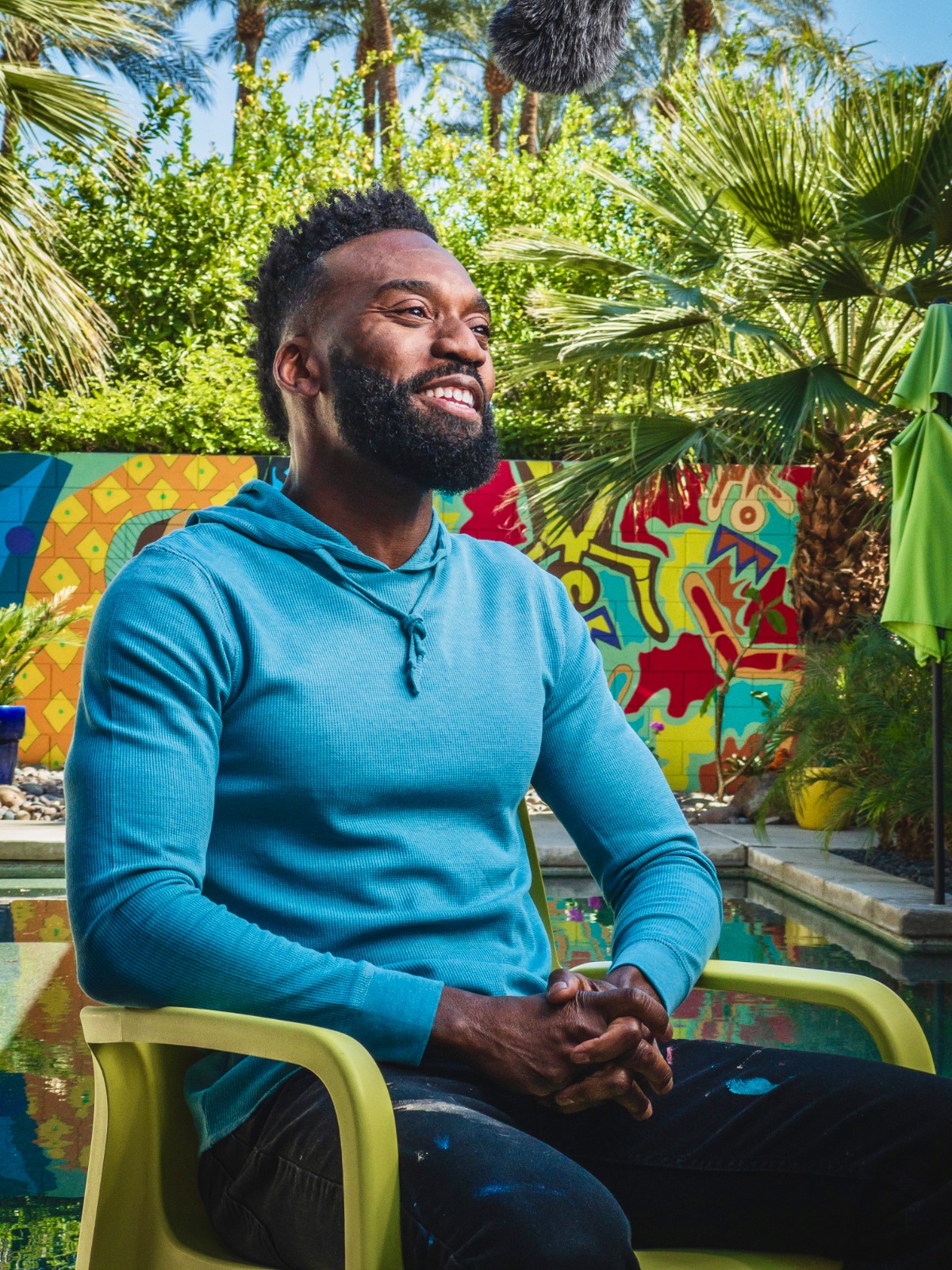Business
Illuminating Streets and Hearts: Tysen Knight’s Artistry of Hope

In the modern tapestry of artistic expression, street art has emerged as a vibrant and powerful medium. It decorates public spaces, breathing life into walls, sidewalks, and buildings, often conveying profound messages with its vivid designs. Despite its controversial origins, street art has captured the imagination of people worldwide, transcending boundaries and resonating with diverse audiences. Among the luminaries of this realm stands Tysen Knight, whose art radiates hope and positivity, transcending mere aesthetics.
Tysen Knight has become a recognizable figure in the world of street art, his captivating works adorning the landscapes of the valley. With creations that have captured the hearts of both local communities and international art enthusiasts, his artistry knows no bounds, showcased in public spaces and exclusive collections across the globe.
Drawing from influences as diverse as Buddha’s teachings and the effervescent spirit of pop art, Knight’s creations are imbued with the essence of street art icons like Jean-Michel Basquiat and Keith Haring, as well as the timeless brilliance of Pablo Picasso and pop culture icon Andy Warhol. A true polymath, Knight’s talents extend beyond street art, embracing the realms of muralist, filmmaker, and artist.
Among his crowning achievements is the celebrated documentary, “The Art of Hustle: Street Art Documentary.” This transformative piece marked a pivotal juncture in his career, propelling him from a street artist to a gallery contributor. Garnering recognition in the form of the “Best Feature Film” award at the Oregon Documentary Film Festival in 2018, the documentary artfully encapsulates not only Knight’s artistic prowess but also his journey of tenacity and dedication.
Knight’s artistic zeal is as much a community endeavour as a personal one. Initiatives like the “Street Bench Art Pilot” exemplify his dedication to engaging with the local populace. By adorning downtown Palm Springs benches with visually arresting designs, he has melded his unique artistic vision with the city’s vibrant fabric. These creations, adorned with figures like Garland, Warhol, Basquiat, Haring, Kahlo, and Lucille Ball, offer a tapestry of the street art world’s diverse and dynamic essence.
His “Masterpiece Mash-Up Series” showcases Knight’s ingenious reimagining of works by esteemed artists such as Pablo Picasso, Leonardo Da Vinci, and Grant Wood. The series debuted in the heart of New York City’s Times Square, earning acclaim from both connoisseurs and critics.
Yet, beyond accolades, Knight’s art has a heart. He is a philanthropist at his core, collaborating with organizations like Habitat for Humanity and the Midnight Mission. By constructing homes for the underprivileged and providing meals for the homeless, he transforms his art into an instrument of change, crafting hope from the very spaces he embellishes.
As the Artist Educator-in-Residence at the Palm Springs Art Museum, Knight’s legacy is one of mentorship and inspiration. Through his guidance, aspiring artists are empowered to forge their creative paths, echoing his indelible mark on the institution.
Knight’s influence doesn’t end with his artistic endeavours; it extends into education. The Tysen Knight Scholarship Fund, initiated by him, empowers high school students with a passion for the arts. By offering financial support, he ensures that artistic dreams aren’t constrained by financial limitations.
Tysen Knight’s journey is an ode to the transformative power of street art. Through his vibrant creations, he rejuvenates communities, imparts inspiration to individuals, and becomes a beacon of hope for emerging artists. His artistic mastery and unwavering commitment continue to enrich the world of street art, leaving an enduring imprint on the hearts and minds of many.
Business
13 Reasons Investors Are Watching Phoenix Energy’s Expansion in the Williston Basin

As energy security becomes a growing priority in the United States, companies focused on domestic oil production are gaining attention from investors. One such company is Phoenix Energy, an independent oil and gas company operating in the Williston Basin, a prolific oil-producing region spanning North Dakota and Montana.
Phoenix Energy has established itself as a key player in this sector, expanding its footprint while offering structured investment opportunities to accredited investors. Through Regulation D 506(c) corporate bonds, the company provides investment options with annual interest rates ranging from 9% to 13%.
Here are 13 reasons why Phoenix Energy is attracting investor interest in 2025:
1. U.S. energy production remains a strategic priority
The global energy landscape is evolving, with a renewed focus on domestic oil and gas production to enhance economic stability and reduce reliance on foreign energy sources. The Williston Basin, home to the Bakken and Three Forks formations, continues to play a critical role in meeting these demands. Phoenix Energy has established an operational footprint in the basin, where it is actively investing in development and production.
2. Investment opportunities with fixed annual interest rates
Phoenix Energy bonds offer accredited investors annual interest rates between 9% and 13% through Regulation D 506(c). These bonds help fund the company’s expansion in the Williston Basin, where it acquires and develops oil and gas assets.
3. Record-breaking drilling speeds in the Williston Basin
Phoenix Energy has made significant strides in drilling efficiency, ranking among the fastest drillers in the Bakken Formation as of late 2024. By reducing drilling times, the company aims to optimize operations and improve overall production performance.
4. Expansion of operational footprint
Since becoming an operator in September 2023, Phoenix Energy has grown rapidly. As of March 2025, the company has 53 wells drilled and 96 wells planned over the next 12 months.
5. Surpassing production expectations
Phoenix Energy’s oil production has steadily increased. By mid-2024, its cumulative production had exceeded 1.57 million barrels, outpacing its total output for 2023. The company projected an exit rate of nearly 20,000 barrels of oil equivalent per day by the end of March 2025.
6. High-net-worth investor offerings
For investors seeking alternative investments with higher-yield opportunities, Phoenix Energy offers the Adamantium bonds through Reg D 506(c), which provides corporate bonds with annual interest rates between 13% and 16%, with investment terms ranging from 5 to 11 years, and a minimum investment of $2 million.
7. Experienced team with industry-specific expertise
Phoenix Energy’s leadership and technical teams include professionals with decades of oil and gas experience, including backgrounds in drilling engineering, land acquisition, and reservoir analysis. This level of in-house expertise supports the company’s ability to evaluate acreage, manage operations, and execute its long-term development plans in the Williston Basin.
8. Focus on investor communication and understanding
Phoenix Energy prioritizes clear investor communication. The company hosts webinars and provides access to licensed professionals who walk investors through the business model and operations in the oil and gas sector. These efforts aim to help investors better understand how Phoenix Energy deploys capital across mineral acquisitions and operated wells.
9. Managing market risk through strategic planning
The energy sector is cyclical, and Phoenix Energy takes a structured approach to risk management. The company employs hedging strategies and asset-backed financing to help mitigate potential fluctuations in the oil market.
10. Commitment to compliance
Phoenix Energy conducts its bond offerings under the SEC’s Regulation D Rule 506(c) exemption. These offerings are made available exclusively to accredited investors and are facilitated through a registered broker-dealer to support adherence to federal securities laws. Investors can review applicable offering filings on the SEC’s EDGAR database.
11. Recognition for business practices
As of April 2025, Phoenix Energy maintains an A+ rating with the Better Business Bureau (BBB) and is a BBB-accredited business. The company has also earned strong ratings on investor review platforms such as Trustpilot and Google Reviews, where investors often highlight clear communication and transparency.
12. A family-founded business with a long-term vision
Led by CEO Adam Ferrari, Phoenix Energy operates as a family-founded business with a focus on long-term investment strategies. The company’s leadership emphasizes responsible growth and sustainable development in the Williston Basin.
13. Positioned for long-term growth in the oil sector
With U.S. energy demand projected to remain strong, Phoenix Energy is strategically positioned for continued expansion. The company’s focus on efficient drilling, financial discipline, and structured investment offerings aligns with its goal of building a resilient and growth-oriented business.
Final thoughts
For investors looking to gain exposure to the U.S. oil and gas sector, Phoenix Energy presents an opportunity to participate in a structured alternative investment backed by the company’s operational expansion in the Williston Basin.
Accredited investors interested in learning more can attend one of Phoenix Energy’s investor webinars, which are hosted daily throughout the week. These sessions provide insights into market trends, risk management strategies, and investment opportunities.
For more information, visit the Phoenix Energy website.
Phoenix Capital Group Holdings, LLC is now Phoenix Energy One, LLC, doing business as Phoenix Energy. The testimonials on review sites may not be representative of other investors not listed on the sites. The testimonials are no guarantee of future performance or success of the Company or a return on investment. Alternative investments are speculative, illiquid, and you may lose some or all of your investment. Securities are offered by Dalmore Group member FINRA/SIPC. Dalmore Group and Phoenix Energy are not affiliated. See full disclosures.
This article contains forward-looking statements based on our current expectations, assumptions, and beliefs about future events and market conditions. These statements, identifiable by terms such as “anticipate,” “believe,” “intend,” “may,” “expect,” “plan,” “should,” and similar expressions, involve risks and uncertainties that could cause actual results to differ materially. Factors that may impact these outcomes include changes in market conditions, regulatory developments, operational performance, and other risks described in our filings with the U.S. Securities and Exchange Commission. Forward-looking statements are not guarantees of future performance, and Phoenix Energy undertakes no obligation to update them except as required by law.
-

 Tech4 years ago
Tech4 years agoEffuel Reviews (2021) – Effuel ECO OBD2 Saves Fuel, and Reduce Gas Cost? Effuel Customer Reviews
-

 Tech6 years ago
Tech6 years agoBosch Power Tools India Launches ‘Cordless Matlab Bosch’ Campaign to Demonstrate the Power of Cordless
-

 Lifestyle6 years ago
Lifestyle6 years agoCatholic Cases App brings Church’s Moral Teachings to Androids and iPhones
-

 Lifestyle4 years ago
Lifestyle4 years agoEast Side Hype x Billionaire Boys Club. Hottest New Streetwear Releases in Utah.
-

 Tech6 years ago
Tech6 years agoCloud Buyers & Investors to Profit in the Future
-

 Lifestyle5 years ago
Lifestyle5 years agoThe Midas of Cosmetic Dermatology: Dr. Simon Ourian
-

 Health6 years ago
Health6 years agoCBDistillery Review: Is it a scam?
-

 Entertainment6 years ago
Entertainment6 years agoAvengers Endgame now Available on 123Movies for Download & Streaming for Free
